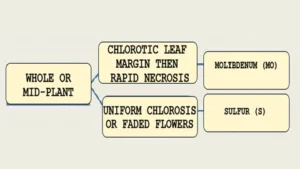A Step-By-Step Guide To Diagnosing Cannabis Deficiencies
We’ve all heard the expression, ‘part of a nutritionally-balanced diet,’ in ads touting health foods. It is common knowledge that good nutrition requires a variety of foods to source the essential vitamins, minerals, carbohydrates, proteins, etc., that our bodies need. The same is true for plant nutrition, and if you are looking to grow some good weed, proper cannabis nutrition is essential. If nutritional needs are met cannabis deficiencies will occur. Cannabis nutrient deficiencies are caused by environmental factors (growing medium, temperature, humidity, lighting, pH & EC) creating conditions that limit nutrient uptake by the roots.
Cannabis, despite what some may say, is not a complex plant to grow. Cannabis generally grows quite vigorously, after all, it is called weed for a reason. Intermediate hydroponic growers go for more involved feeding regimens, like the Npsoils products to increase nutrient efficiency, plant metabolism and push a cannabis plant to its maximum potential for yield and quality. This type of feeding regime is akin to a high-performance athlete’s diet.

Easy Plus Grow and Bloom on the other hand, is specifically designed for beginners, to prevent cannabis nutrient deficiencies and balance pH with just a couple teaspoons in a watering can.

Thankfully, products like these simplify the fertigation process to prevent lockouts and deficiencies from occurring in the first place.
That said, one of the trickiest aspects to growing cannabis is accurately diagnosing or ruling-out potential cannabis nutrient deficiencies. Differentiating between the common symptoms (like yellowing leaves) and the subtle differences in the way deficiencies present themselves can stump the most experienced growers.
This article aims to arm you with some useful diagnostic tools to point you in the right direction if you suspect you are seeing deficiency symptoms. We will give you a very simple, yet effective, order of operations to follow.
What Is A Cannabis Nutrient Deficiency?
In the simplest terms, a cannabis nutrient deficiency is when your plant’s roots are unable to source the essential macronutrients and micronutrients for healthy growth. A nutrient deficient plant may die if the problem is not addressed. A nutrient deficiency can also increase susceptibility to cannabis pests and diseases. They manifest through a variety of symptoms to the foliage, roots and plant structure.
What Is A Cannabis Nutrient Toxicity?
An excess of one, or several of the essential nutrients is sometimes known as a nutrient toxicity. This occurs when an excess concentration of fertilizer is given to the plant. This results in salt accumulating in your medium which can be flushed with fresh water in most cases. Growers often refer to nutrient toxicity as nutrient burn and the most common symptom of this would be foliage that has yellow or dying leaflet tips.
How Does pH Affect Cannabis Nutrition?
Each essential nutrient has a unique rate of absorption by the root in relation to pH. We recommend maintaining a pH between 5.8-6.3 when using Npsoils products for maximum absorption rates of all 12 essential nutrients. It is best to try to maintain a steady pH without significant fluctuations in readings. To understand nutrient availability in relation to pH at-a-glance, nutrient availability charts can provide a good visual reference.
Thankfully, products like these simplify the fertigation process to prevent lockouts and deficiencies from occurring in the first place.
That said, one of the trickiest aspects to growing cannabis is accurately diagnosing or ruling-out potential cannabis nutrient deficiencies. Differentiating between the common symptoms (like yellowing leaves) and the subtle differences in the way deficiencies present themselves can stump the most experienced growers.
This article aims to arm you with some useful diagnostic tools to point you in the right direction if you suspect you are seeing deficiency symptoms. We will give you a very simple, yet effective, order of operations to follow.
What Is A Cannabis Nutrient Deficiency?
In the simplest terms, a cannabis nutrient deficiency is when your plant’s roots are unable to source the essential macronutrients and micronutrients for healthy growth. A nutrient deficient plant may die if the problem is not addressed. A nutrient deficiency can also increase susceptibility to cannabis pests and diseases. They manifest through a variety of symptoms to the foliage, roots and plant structure.
What Is A Cannabis Nutrient Toxicity?
An excess of one, or several of the essential nutrients is sometimes known as a nutrient toxicity. This occurs when an excess concentration of fertilizer is given to the plant. This results in salt accumulating in your medium which can be flushed with fresh water in most cases. Growers often refer to nutrient toxicity as nutrient burn and the most common symptom of this would be foliage that has yellow or dying leaflet tips.
How Does pH Affect Cannabis Nutrition?
Each essential nutrient has a unique rate of absorption by the root in relation to pH. We recommend maintaining a pH between 5.8-6.3 when using Npsoils products for maximum absorption rates of all 12 essential nutrients. It is best to try to maintain a steady pH without significant fluctuations in readings. To understand nutrient availability in relation to pH at-a-glance, nutrient availability charts can provide a good visual reference.
Follow these steps to make your cannabis deficiency diagnosis:
If you are running multiple plants, check that all of the same strain with the same irrigation are displaying like-symptoms. If only one plant is symptomatic it could be pest or disease related foliar damage. It is best to eliminate the possibility of plant disease or pest infestation prior to taking any action.
Test the pH of your irrigation water and your media. A pH between 5.8-6.3 should be maintained throughout the entire duration of the growing cycle. Use the pour-thru or saturated media methods to test the pH and electrical conductivity (EC) of your media if you are a soil grower. Always make sure to calibrate your pH meters prior to testing.
Are symptoms appearing at the base or top of the plant? Again this will tell you whether your deficiency is mobile or immobile, which is fundamental to identifying nutrient deficiency symptoms. Old growth showing symptoms first = a mobile nutrient deficiency. New growth displaying symptoms = an immobile nutrient deficiency.
Reference a deficiency key
A nutrient deficiency key is based on the dichotomous key method of identification where certain two specific traits of deficiency symptoms are compared. This is followed by a sequence of comparisons that repeat until identification can be determined.
Consult a trusted cannabis cultivation resource for a second opinion. If you’ve followed a deficiency key but are still uncertain as to what your deficiency may be, it is wise to consult a trusted source, who can take a second look at the symptoms. If money or time are not a concern for you, one can send in tissue samples to a reputable nearby lab for testing.
Final Thoughts
Diagnosing specific nutrient deficiencies is a skill that can take years to develop. Since nutrient formulations come in pre-mixed ratios of all essential nutrients, the remedy in most cases is to flush, calibrate and remix your solution. If your plant is displaying deficiency or toxicity symptoms, chances are that pH and the ratios of total dissolved solids in your solution are out of optimal range. A quality pH and EC/PPM (and calibrated) meter, such as the Growboss by Nutradip, is key to properly monitoring your crop. Nutradip offers calibration solutions for their probes as well.
When it comes to plant health, prevention is always better than reactive treatment. Quality base nutrients like Future Harvest’s Holland Secret or our Easy Plus line are a paramount to preventing nutrient deficiencies in the first place. Understanding the characteristics of your genetics, potential pest and disease issues, optimal environmental conditions, your growing media characteristics, and adhering to the dilution ratios provided by your Future Harvest feeding schedule will go a long way in maintaining a healthy plant from seed to harvest.

For more information on the prevention, symptoms, and treatment of the most common nutrient deficiencies that occur in cannabis cultivation, click here!















Google sıralamaları SEO çalışmaları, Google’da üst sıralara çıkmamıza yardımcı oldu. https://www.royalelektrik.com/celiktepe-elektrikci/
Модные советы по выбору модных видов на любой день.
Обзоры профессионалов, события, все показы и мероприятия.
https://megakazan.ru/kzn/403-5-luchshih-sumok-balmain-na-2024-god-stil-i-elegantnost-ot-frantsuzskogo-doma-mody/
Стильные заметки по подбору крутых образов на каждый день.
Обзоры профессионалов, события, все новинки и шоу.
https://sochidaily.ru/read/2024-09-10-demna-gvasaliya-ikona-sovremennoy-mody-i-kreativnyy-revolyutsioner
Keep up the fantastic work! Kalorifer Sobası odun, kömür, pelet gibi yakıtlarla çalışan ve ısıtma işlevi gören bir soba türüdür. Kalorifer Sobası içindeki yakıtın yanmasıyla oluşan ısıyı doğrudan çevresine yayar ve aynı zamanda suyun ısınmasını sağlar.
Bulgurlu su kaçağı tespiti Güngören su kaçağı tespiti: Güngören’de su kaçaklarına profesyonel müdahale. https://ceskanaike.com/ustaelektrikci
Beykoz su kaçak tespiti Güngören’deki evimizdeki su kaçağını çok hızlı tespit ettiler. Gerçekten profesyonel bir hizmet. https://together-19.com/ustaelektrikci
Karaköy su kaçak tespiti Bahçelievler’deki evimizdeki su kaçağını buldular ve hemen onardılar. Çok profesyoneller. https://www.messifootballforum.com/ustaelektrikci
İstanbul su kaçağı tamir servisi Kadıköy’deki evimizde su kaçağı tespiti için çağırdık, hızlı ve doğru çözüm sundular. https://prosafely.com/ustaelektrikci
cihazla su kaçak tespiti Maslak’ta su kaçağını Testo termal kameralarla tespit ettiler. Çok hızlı bir çözüm sundular. https://hallbook.com.br/ustaelektrikci
Thanks for every other fantastic post. The place else may just anybody get that type of info in such an ideal means of writing? I’ve a presentation subsequent week, and I’m on the look for such information.
http://www.vorbelutrioperbir.com
Bakırköy su kaçak tespiti Bodrumdaki su sızıntısını özel cihazlarla tespit ettiler. Kalıcı çözüm sundular. Necdet G. https://roadcosmos.com/author/kacak/
Abluka – Saldırganın kullandığı takma ad “Kadir Saraçoğlu”‘nun fidye yazılımı geliştirme sürecindeki diğer suç ortakları incelenebilir. https://app.socie.com.br/read-blog/169728